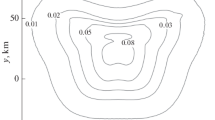Abstract
Numerical simulation of atmospheric disturbances during the first hours after the Chelyabinsk and Tunguska space body impacts has been carried out. The results of detailed calculations, including the stages of destruction, evaporation and deceleration of the cosmic body, the generation of atmospheric disturbances and their propagation over distances of thousands of kilometers, have been compared with the results of spherical explosions with energy equal to the kinetic energy of meteoroids. It has been shown that in the case of the Chelyabinsk meteorite, an explosive analogy provides acceptable dimensions of the perturbed region and the perturbation amplitude. With a more powerful Tunguska fall, the resulting atmospheric flow is very different from the explosive one; an atmospheric plume emerges that releases matter from the meteoric trace to an altitude of the order of a thousand kilometers.
Similar content being viewed by others
References
Artemieva, N.A. and Shuvalov, V.V., From Tunguska to Chelyabinsk via Jupiter, Annu. Rev. Earth Planet. Sci., 2016, vol. 44, pp. 37–56.
Berngardt, O.I., Perevalova, N.P., Kutelev, K.A., Zherebtsov, G.A., Dobrynina, A.A., Shestakov, N.V., Zagretdinov, R.V., Bakhtiyarov, V.F., and Kusonsky, O.A., Toward the azimuthal characteristics of ionospheric and seismic effects of “Chelyabinsk” meteorite fall according to the data from coherent radar, GPS, and seismic networks, J. Geophys. Res., 2015, vol. 120, no. 12, pp. 10754–10771.
Bilitza, D., Altadill, D., Altadill, D., Zhang, Y., Zhang, Y., Mertens, C., Mertens, C., Truhlik, V., Truhlik, V., Richards, P., Richards, P., McKinnell, L.-A., McKinnell, L.-A., and Reinisch, B., The International Reference Ionosphere 2012—a model of international collaboration, J. Space Weath. Space Clim., 2014, vol. 4, no. A07, p. 12.
Boslough, M.B. and Crawford, D.A., Shoemaker-Levy 9 and plume-forming collisions on Earth, Proc. United Nations Int. Conf. “Near-Earth Objects,” Remo, J.L., Ed., New York: NY Acad. Sci., 1997, pp. 236–282.
CIRA, COSPAR International Reference Atmosphere, Amsterdam: North Holland, 1961.
Gokhberg, M.B., Ol’shanskaya, E.V., Steblov, G.M., and Shalimov, S.L., The Chelyabinsk meteorite: Ionospheric response based on GPS measurements, Dokl. Earth Sci., 2013, vol. 452, no. 1, pp. 948–952.
Gokhberg, M.B., Ol’shanskaya, E.V., Steblov, G.M., and Shalimov, S.L., The ionospheric response to the acoustic signal from submarine earthquakes according to the GPS data, Izv. Phys. Solid Earth, 2014, vol. 50, no. 1, pp. 1–8.
Hedin, A.E., Extension of the MSIS thermosphere model into the middle and lower atmosphere, J. Geophys. Res.: Space Phys., 1991, vol. 96, no. 2, pp. 1159–1172.
Hernández-Pajares, M., Juan, J.M., and Sanz, J., Medium-scale traveling ionospheric disturbances affecting GPS measurements: Spatial and temporal analysis, J. Geophys. Res., 2006, vol. 111, pp. 1–13.
Huang, K.M., Zhang, S.D., Yi, F., Huang, C.M., Gan, Q., Gong, Y., and Zhang, Y.H., Nonlinear interaction of gravity waves in a nonisothermal and dissipative atmosphere, Ann. Geophys., 2014, vol. 32, pp. 263–275.
Ivanov, K.G., Geomagnetic effect of the Tunguska meteorite fall, Meteoritika, 1964, no. 24, pp. 141–151.
Khazins, V.M. and Shuvalov, V.V., Numerical modeling of acoustic-gravitational waves initiated by the fall of a meteoroid, in Dinamicheskie protsessy v geosferakh (Dynamic Processes in Geospheres), Nauch. Tr. Inst. Din. Geosfer, Ross. Akad. Nauk, Moscow: GEOS, 2016, no. 8, pp. 197–207.
Kuznetsov, N.M., Termodinamicheskie funktsii i udarnye adiabaty vozdukha pri vysokikh temperaturakh (Thermodynamic Functions and Impact Adiabats of Air at the High Temperatures), Moscow: Mashinostroenie, 1965.
Perevalova, N.P., Shestakov, N.V., Voeykov, S.V., Takahashi, H., and Guojie, M., Ionospheric disturbances in the vicinity of the Chelyabinsk meteoroid explosive disruption as inferred from dense GPS observations, Geophys. Res. Lett., 2015, vol. 42, pp. 6535–6543.
Popova, O.P., Jenniskens, P., Emel’yanenko, V., Kartashova, A., Biryukov, E., Khaibrakhmanov, S., Shuvalov, V., Rybnov, Y., Dudorov, A., Grokhovsky, V.I., Badyukov, D.D., Yin, Q.-Z., Gural, P.S., Albers, J., Granvik, M., et al., Chelyabinsk airburst, damage assessment, meteorite recovery, and characterization, Science, 2013, vol. 342, no. 6162, pp. 1069–1073.
Ruzhin, Y.Y., Kuznetsov, V.D., and Smirnov, V.M., Ionospheric response to the entry and explosion of the South Ural superbolide, Geomagn. Aeron., 2014a, vol. 54, no. 5, pp. 601–612.
Ruzhin, Yu.Ya., Kuznetsov, V.M., and Smirnov, V.M., The ionosphere effects of the Chelyabinsk meteoroid explosion, Int. J. Electron. Appl. Res., 2014b, vol. 1, no. 2, pp. 39–60.
Shuvalov, V.V., Multi-dimensional hydrodynamic code SOVA for interfacial flows: application to thermal layer effect, Shock Waves, 1999a, vol. 9, no. 6, pp. 381–390.
Shuvalov, V.V., Atmospheric plumes created by meteoroids impacting the Earth, J. Geophys. Res.: Planets, 1999b, vol. 104, no. 3, pp. 5877–5890.
Shuvalov, V.V. and Artemieva, N.A., Numerical modeling of Tunguska-like impacts, Planet. Space Sci., 2002, vol. 50, pp. 181–192.
Shuvalov, V.V., Popova, O.P., Svettsov, V.V., Trubetskaya, I.A., and Glazachev, D.O., Determination of the height of the “meteoric explosion,” Sol. Syst. Res., 2016, vol. 50, no. 1, pp. 1–12.
Shuvalov, V.V., Svettsov, V.V., Artem’eva, N.A., Trubetskaya, I.A., Popova, O.P., and Glazachev, D.O., Asteroid Apophis: evaluating the impact hazards of such bodies, Sol. Syst. Res., 2017, vol. 51, no. 1, pp. 44–58.
Voeykov, S.V., Berngardt, O.I., and Shestakov, N.V., Use of the index of TEC vertical variation disturbance in studying ionospheric effects of the Chelyabinsk meteorite, Geomagn. Aeron., 2016, vol. 56, no. 2, pp. 219–228.
Xu, J., Smith, A.K., and Ma, R., A numerical study of the effect of gravity-wave propagation on minor species distributions in the mesopause region, J. Geophys. Res.: Atmos., 2003, vol. 108, no. 3, pp. 1–12.
Author information
Authors and Affiliations
Corresponding author
Additional information
Original Russian Text © V.V. Shuvalov, V.M. Khazins, 2018, published in Astronomicheskii Vestnik, 2018, Vol. 52, No. 2, pp. 142–151.
Rights and permissions
About this article
Cite this article
Shuvalov, V.V., Khazins, V.M. Numerical Simulation of Ionospheric Disturbances Generated by the Chelyabinsk and Tunguska Space Body Impacts. Sol Syst Res 52, 129–138 (2018). https://doi.org/10.1134/S0038094618010094
Received:
Published:
Issue Date:
DOI: https://doi.org/10.1134/S0038094618010094



